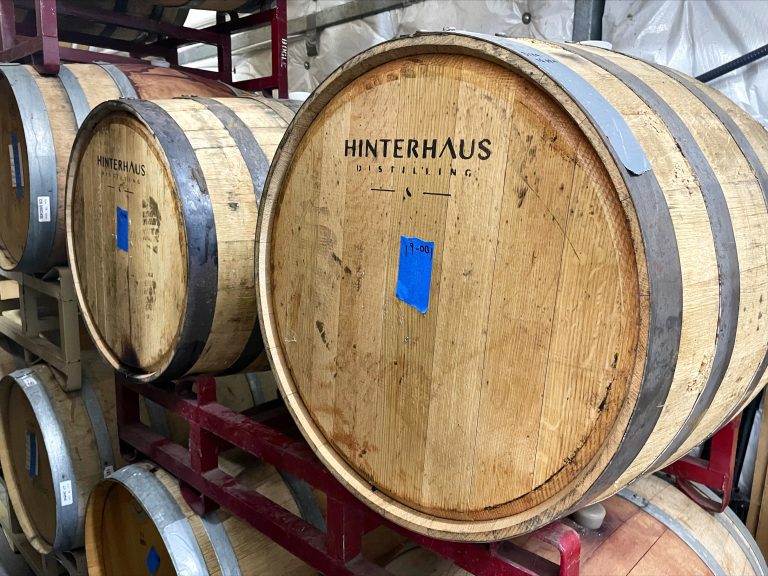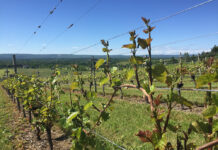
Sales of wines aged in bourbon barrels have increased dramatically in recent years. Originally a cost-saving practice for winemakers, the current popularity of these wines is a result of the way the used barrels enhance their taste and aroma.
“By using bourbon-aged barrels, we get entirely different components, smells and flavors than we do with traditional wine barrels,” said Ellie Farrell, public relations manager for Treasury Wine Estates, an international wine company based in Australia with U.S. locations in Oakland and Napa. “Our American oak barrels introduce warm aromas and flavors of vanilla, caramel, roasted hazelnuts, butterscotch and baking spice.”
Treasury Wine Estates has more than 40 wine brands, including Beringer Vineyards, one of the first companies to use bourbon barrels to age wine.
“150 years ago, brothers Jacob and Frederick Beringer left Germany to establish a winery and distillery in Napa,” said Farrell. “Historically, wine producers used whatever was readily available to ferment and even store their wines, including various wood tanks like redwood or oak. To Jacob and Frederick, reusing their spirit barrels to age wine just seemed like good financial sense, and they quickly discovered it added a whole new level of complexity.”
Bourbon barrels also reduce the time necessary to age wine, according to Farrell. “After being fermented in stainless steel tanks, our wines are aged in second-pass-charred American oak bourbon barrels for 60 days.”
She added that Beringer Vineyards makes wine using traditional winemaking practices, including aging wine in spirits barrels. Even the company’s bourbon barrel aging process has remained fairly consistent.
“We’ve made a few tweaks here and there, but overall, the process has stayed the same,” said Farrell.
“Because the toasting for bourbon barrels is different and more aggressive than for wine, we only age 20% of the wine in bourbon barrels,” said Farrell, adding that red blend, cabernet sauvignon and chardonnay are among the types of wine benefitting the most from bourbon barrel aging Beringer prefers used bourbon barrels to new, according to Farrell. “The average age of our used barrels is four years,” she said. “We’ve found by using used bourbon barrels, we get better integration of flavors as well as unique flavors, resulting in better quality wines.”
Process Also Benefits Newcomers
Even winemakers without a long history are finding success aging their wine in bourbon barrels.
“We’re new to the business,” said Rob Hendriks, co-owner of Aloria Vineyards based in Murphys, Calif., which started using bourbon barrels in 2020.
“We have four bourbon barrels and we put our port in them,” he said. “Basically, the wine we had was all finished, already aged. We put it into bourbon barrels to pick up the flavor.”
Hendriks described Aloria’s port wines as “all dry and not sweet,” and said that the bourbon barrel aging process adds “some caramel overtones to it.
“The response is usually pretty positive when people taste our fortified ports,” he said, proudly noting that the Aloria 2016 Forté Estate Bourbon Barrel Aged Syrah was one of the “seven bourbon barrel-aged wines to try,” according to Wine Enthusiast.
“It’s just a flavor category that people seem to like,” said Alison Crowe, partner and vice president of winemaking at Plata Wine Partners, the winemaking arm of Silverado Wine Growers. “It’s certainly been increasingly common in the last five-to-seven years.”
Plata Wine Partners makes three wines with the Big Six Bourbon Barrel label, a cabernet sauvignon, a red blend and a zinfandel, which are sold through Total Wine & More.
Crowe described her company’s bourbon barrel wines as having “big bold ‘jammy’ flavors, fruity and sweet with very apparent fruity flavors like blackberry, raspberry and cherry.
“Red blend and cabernet lend themselves to this style,” she added. “Everyone may have different opinions, but the consensus is the best wine tone to pair with bourbon barrels is something smoky.”
She said that wines with crisp floral aromas such as riesling are not a good match for bourbon barrel aging. “It’s like cooking; you have to think about what spices go with what you are making,” she said, noting that wineries add ingredients to give their wines more complexities.
Crowe described the flavors suggested by bourbon barrel-aged wine as vanilla, clove, warm baking spices, cinnamon, toasted coffee, toffee and caramel, but added, “Actually, it’s more complex than that.”
Only some wood is good for wine barrels, she said. “You can’t make barrels out of eucalyptus. They won’t hold together.”
Oak barrels are best, specifically, barrels made from French or American oak, according to Crowe. “Our French oak barrels are brought over by ship or airplane.
“I wouldn’t want a new bourbon barrel,” she said, explaining that bourbon barrels are flame-charred using high heat, which burns the barrel and creates a flavor that can be very dominant. Traditionally, winemakers prefer to age wine in gently toasted barrels, slightly above light to medium charring.”
Because of the charring, she advises those using bourbon barrels to age wine to test it often. “Make sure you’re not overdoing it.”
Even with the required testing, Crowe believes that the process of using bourbon barrels to age wine is here to stay. “It may seem kind of gimmicky, but there’s a long history of these vessels in our history,” she said. “What’s old is new again.”
Consistency and a Good Story
“People don’t just want Budweiser and Coors or Jack Daniels anymore,” said Marc Hillier, owner/president of Country Connection, Inc., a company headquartered in Oroville, Calif. that supplies barrels to winemakers, brewers and distillers. “They want something unique and interesting. If you can say your wine was finished with a French oak bourbon barrel in the Napa wine region, it makes a good story.”
Hiller started Country Connection in 2005 because he “fell in love with the barrel, and the smell of wine and bourbon in the barrel.”
Country Connection went through some early challenges, but Hillier said his company had strong growth in 2009 and again in 2013-14, and is experiencing “amazing growth now.” He said he “learned everything through youth and hard work.”
While the demand from wineries for Country Connection’s bourbon barrels has increased, winemakers’ preferences have remained the same, at least most of the time.
“I’m not seeing a whole lot of change,” said Hillier, “but one winery asked if I ever have tequila barrels, and I have provided rum barrels.”
The main priority of wineries is that the bourbon barrels they receive are as similar as possible.
“People like consistency,” Hillier said. “If you’re going to develop a brand, your customers expect the same flavor. Wineries also prefer barrels that are unrinsed,” explaining that some distillers wash their barrels and use the water to dilute the alcohol content in their whiskeys. While that may be a good business practice for distillers, it causes wineries to lose the bourbon flavors in the barrels.








